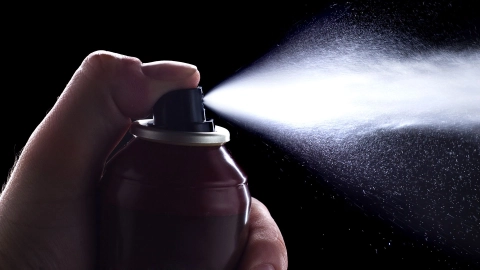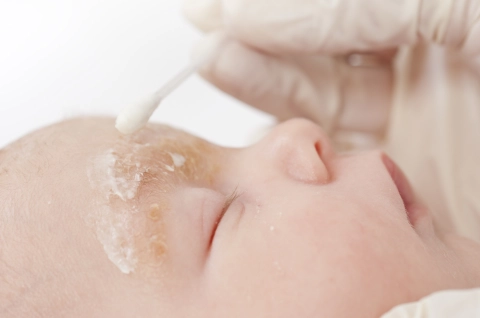Conditions Dyshidrotic eczema
ICD codes: L30.1 What are ICD codes?
If hands, fingers or soles itch and small blisters form, the rash could be dyshidrotic eczema. Often, there is no clear cause. It is usually treated with anti-inflammatory ointments. It is also important to take good care of the skin and avoid contact with irritating substances.
At a glance
- In dyshidrotic eczema, itchy blisters appear on the palms and fingers, and sometimes also on the soles of the feet.
- The eczema occurs in episodes over months to years, often without a clear trigger.
- Compared to other age groups, dyshidrotic eczema is most common in younger adults.
- Anti-inflammatory ointments can help. In mild cases, it is often also enough to take good care of the skin and avoid contact with irritating substances.
Note: The information in this article cannot and should not replace a medical consultation and must not be used for self-diagnosis or treatment.

What is dyshidrotic eczema?
Dyshidrotic eczema, also called dyshidrosis or dyshidrotic dermatitis, is characterized by intensely itchy blisters on the hands or feet. It occurs most often in younger adults and usually progresses in episodes over a period of months to years. It usually fully subsides as a person ages.
Often, it is unclear why dyshidrosis develops. Sometimes it occurs together with other skin diseases, for example with neurodermatitis, a fungal infection, or with a contact allergy, for example, an allergy to nickel.
Dyshidrotic eczema is treated with anti-inflammatory ointments. In addition, good skin care is essential.
Interesting fact: The name “dyshidrosis” is derived from the Greek word “hidros”, which means sweat. Previously, medical professionals assumed that dyshidrotic eczema was due to a disturbed function of the sweat glands. Medical research today shows that this is not the case. Nevertheless, the historical name is still used.
What are the symptoms of dyshidrotic eczema?
Dyshidrosis often progresses in episodes. Typically, a sudden itching occurs, then strongly itchy blisters form
- on the palms of the hands, usually symmetrically on both hands
- laterally on the fingers
- sometimes also on the soles of the feet.
The blisters can merge into large blisters. Sometimes the symptoms become so severe that people with dyshidrotic eczema cannot go about their daily activities.
Usually, the blisters dry up after a few weeks and heal with scaling. However, if the flare-ups recur frequently, chronic hand eczema may develop. It is accompanied by reddened, scaly, and leathery patches of skin, and sometimes painful cracks in the skin.
What causes dyshidrotic eczema?
The cause of dyshidrotic eczema is unknown.
Medical professionals suspect that certain pre-existing conditions, as well as immune responses and inflammatory reactions to certain stimuli, make a person more susceptible to eczema. These include:
- Neurodermatitis: people with neurodermatitis are more prone to dyshidrotic eczema.
- Contact allergies: substances such as nickel in jewelry, but also fragrances in soaps and cosmetics, cleaning agents or latex can be a trigger and make a person more susceptible to dyshidrotic eczema. It is irrelevant that the allergens make contact directly with the skin on the hands or feet: the triggering contact can also occur on completely different parts of the body.
- Fungal infections of the skin: athlete’s foot, fungal nail infection or ringworm (tinea corporis) are also considered possible triggers of dyshidrosis. Again, an infection on any part of the body can lead to eczema on the hands or feet.
- Smoking
- Medication
- Warm water
- Physical or emotional stress
Sometimes people who sweat excessively (hyperhidrosis) have dyshidrotic eczema. However, according to current understanding, the sweat glands have nothing to do with the development of dyshidrosis.
How is dyshidrotic eczema treated?
Doctors can usually make the diagnosis on the basis of the typical skin changes on the hands and feet and the patient’s medical history. It is important to distinguish dyshidrosis from other skin diseases with in part similar symptoms, such as fungal infections or scabies.
How can dyshidrotic eczema be treated?
As a rule, in the case of dyshidrotic eczema, the affected skin areas are treated only externally with anti-inflammatory ointments, creams or lotions.
Doctors often prescribe cortisone ointments, sometimes also ointments or creams containing drugs known as calcineurin inhibitors. These substances alleviate the immune and inflammatory processes in the skin.
If the dyshidrotic eczema is very severe, doctors sometimes prescribe cortisone tablets.
In severe cases or if other forms of therapy fail, treatment with UV light may also be considered.
Regular skin care, for example with protective skin creams or Vaseline, can also help.
What measures help in everyday life with dyshidrotic eczema?
To prevent certain substances or activities from further irritating the skin and aggravating dyshidrotic eczema, the following measures often help:
- It is best to wash hands with lukewarm water and skin-friendly cleansing products and dry them well.
- When working with water, for example when washing dishes, it is advisable to take off rings, bracelets or watches beforehand.
- It is important to avoid contact with substances known to promote skin reactions: in addition to metals such as nickel, these can include cleaning agents, some hair care products, or acids, such as those found in citrus fruits.
- In addition, it helps to wear protective gloves.
- Deutsche Dermatologische Gesellschaft e.V. (DDG) Kontaktekzem. S1-Leitlinie. doi: 10.1007/s40629-014-0013-5. 08.2013.
- DynaMed (Internet), Ipswich (MA). Dyshidrotic Eczema. EBSCO Information Services. Record No. T114803. 2018 (1995). Aufgerufen am 26.05.2021.
- UpToDate (Internet). Acute palmoplantar eczema (dyshidrotic eczema). Wolters Kluwer 2019. Aufgerufen am 26.05.2021
In cooperation with the Institute for Quality and Efficiency in Health Care (Institut für Qualität und Wirtschaftlichkeit im Gesundheitswesen) (IQWiG).
As at:





